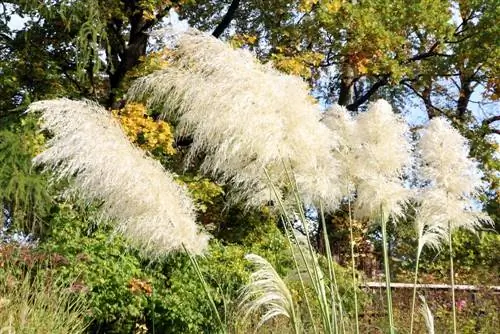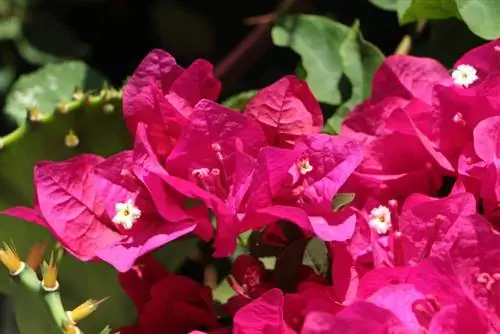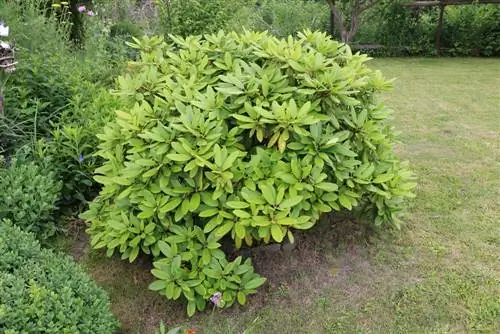- Author admin [email protected].
- Public 2023-12-17 03:39.
- Last modified 2025-06-01 06:48.
Decorative, impressive and easy to care for - wisteria is delighting more and more hobby gardeners. The plant with its lush blue flowers is a visual highlight, especially in the ornamental garden. Every garden owner is even more disappointed when the wisteria does not bloom or only blooms poorly; Then it is important to find the cause of the lazy flowering so that the plant quickly becomes the usual eye-catcher again.
Note location
Cultivation errors are often responsible for the lazy flowering of wisteria; The location in particular plays an important role here. Wisteria thrives best in full sun locations; The flowers can develop optimally here. A warm and sunny south wall is best.
Even if the plant is cultivated in partial shade, significantly fewer flowers form, while a completely shady place can sometimes lead to complete failure.
So that all flowers planted can develop optimally, it is important to choose a spacious location and attach a climbing aid. The following variants have proven themselves:
- Plastic rods
- Metal grille
- Wire ropes
Note:
Wisteria should never be placed too close to a gutter where it could climb up and cause damage.
Choose the optimal substrate
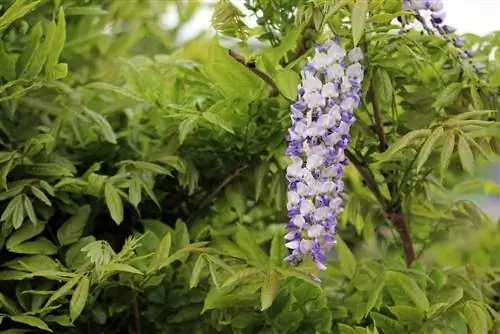
If the wisteria does not bloom or only blooms insufficiently, the use of an unfavorable substrate can also be the cause, because the plant places special demands on the soil. The soil used should be rich in nutrients and low in lime at the same time. If the substrate contains too much lime, not only will the leaves turn yellow, but the general ability to bloom will also decrease. A high proportion of humus, on the other hand, generally has a positive effect on the formation of flowers; It is also important to set the correct pH in the soil. The flowers develop best when the substrate has acidic to neutral properties. The soil should also be moist but permeable to water.
A lot of water promotes flower formation
The wisteria impresses above all with its lush flowers; In order for this to develop optimally, the plant needs a lot of water, especially during the summer months. To ensure that the flow of liquid does not dry up even on hot and dry days, it is a good idea to place the lower part of the plant bowl in the water.
Tip:
The wisteria is one of the few plants that does not react with the dreaded root rot if it is too wet. That's why you can water boldly!
Well-dosed fertilization
The most common reasons for wisteria's lazy flowering include insufficient or incorrect fertilization; Here, even the smallest mistakes can have a maximum effect on the plant's ability to flower or can completely inhibit flower growth. When fertilizing, the following aspects should be taken into account:
- Heavy fertilization takes place after flowering
- This nutrient addition should be done by July
- The fertilizer is then reduced
- Any high-quality flower fertilizer is suitable
By varying the amounts of fertilizer, the hobby gardener ensures that the wisteria sets flower buds for the entire next year and at the same time limits the growth of the foliage during the summer.
Repot wisely
Due to the strong growth of wisteria, many hobby gardeners tend to repot the plant too often. However, frequent pot changes significantly limit flowering, so an interval of at least five years should be maintained between repotting.
Note:
If you repot rarely, you also promote gradual compaction of the root ball, which further promotes the formation of flower buds. In return, however, this compaction makes watering from above more difficult, which is why it is doubly important to water the wisteria from below, especially during the hot season.
Cut back in a targeted manner
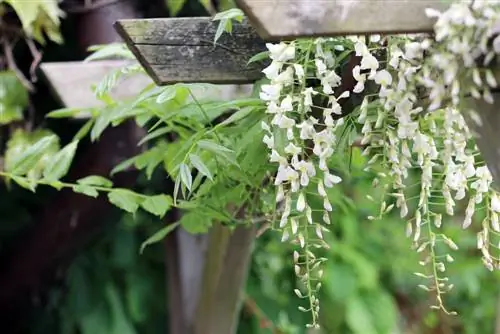
For optimal flower formation, targeted pruning is important. From the third year onwards, this must be done according to the following guidelines:
- New shoots are cut back by half
- Cutting takes place in late summer
- New growths grow again on the cut shoots
- These need to be shortened to three to five eyes at the end of February
- Shoots without greenery must be removed completely
Note:
Incorrect pruning can also accidentally remove shoots that produce flowers. Therefore, cutting young or annual shoots should be avoided; If necessary, leading shoots can be thinned out into the perennial wood.
Older specimens of wisteria often suffer from lazy flowering. Pruning can also help here, which in this case can be radical. If you shorten the plant by 40 to 50cm, you will be able to enjoy numerous new flowers the following year.
Be patient and choose the best variety
If you have taken all of the aspects mentioned into account and still notice a certain lack of flowering in your wisteria, you should keep in mind that the plant will only produce flowers after three years at the earliest. If the plant is not trimmed, the flowers may move even further back. In addition, the right variety of wisteria is crucial for the speed of flowering; Some varieties only produce their first flowers after 10 years. Please note the following information about the varieties and species:
- Japanese wisteria grows weaker and only blooms after 10 years
- Issai Perfect starts blooming after just three years
- Improved plants bloom significantly better
Note:
Plants propagated from seeds rarely flower overall.
The causes of wisteria's lazy flowering are varied. But if the hobby gardener first pays attention to a suitable and fast-flowering variety, then cultivates the plant in a suitable location, cares for it well and prunes it carefully, he can look forward to the lush flowers in his home garden every year.


